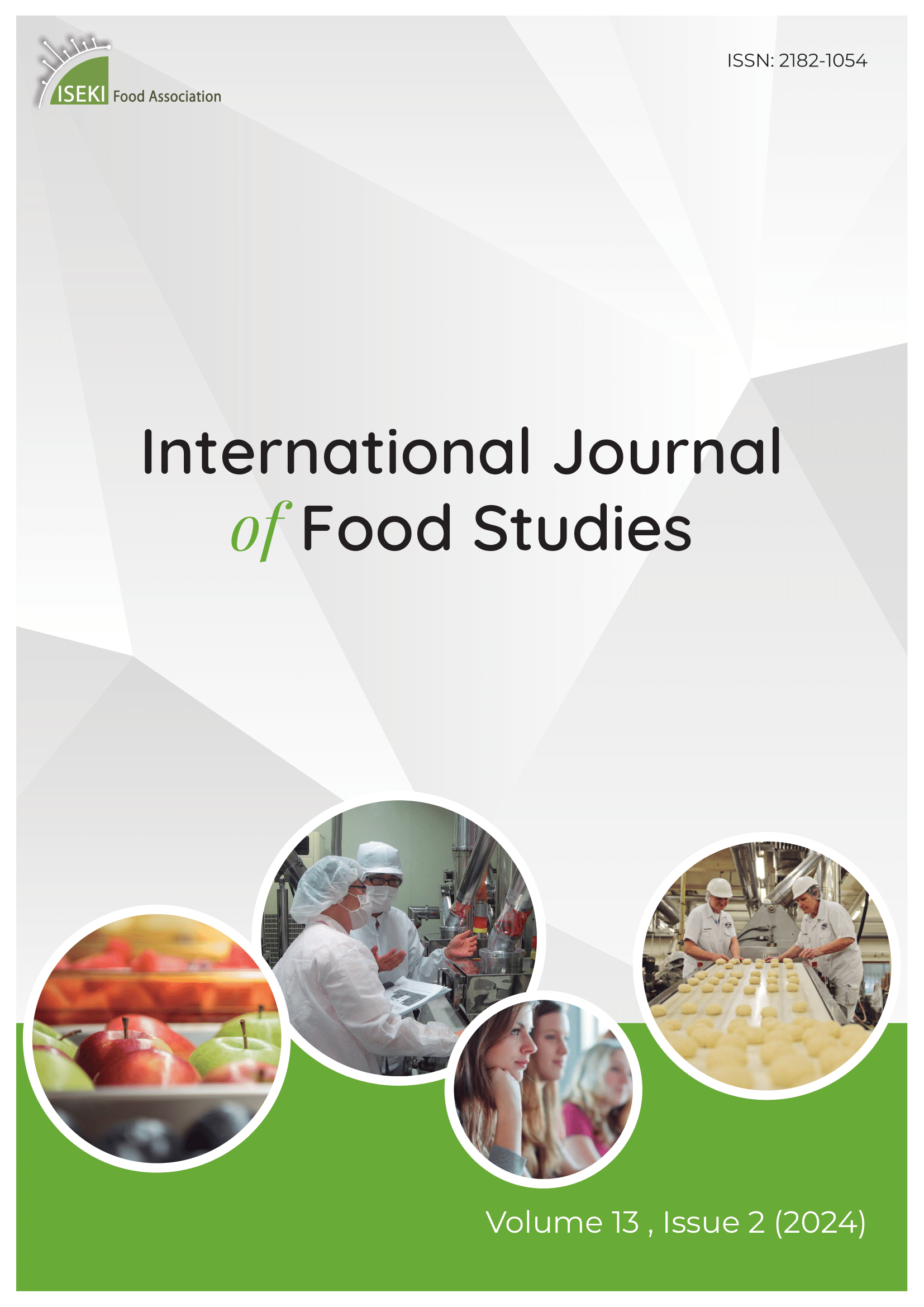Current issue

Volume 13, Issue 2, 2024
Online ISSN: 2182-1054
Volume 13 , Issue 2, (2024)
Published: 18.10.2024.
Open Access
All issues
Contents
24.02.2021.
Original scientific paper
Optimization of a Process for a Microgreen and Fruit Based Ready to Serve Beverage
A process for preparation of a microgreen and fruit based beverage was optimized using spinach (Spinacia oleracea) microgreen, pomegranate (Punica granatum), pineapple (Ananascomosus) and sugar. The blended juice in different ratios was analysed for total soluble solids, viscosity, sedimentation, acidity, metal chelation activity, free radical scavenging activity and reducing power. The optimized beverage had, 17.26 mL 100 mL-1 spinach microgreen juice, 57.07 mL 100 mL-1 pomegranate juice, 1.01 g 100 g-1 sugar and 24.66 mL 100 mL-1 pineapple juice. The product was high in nutrients, particularly protein, minerals (sodium, potassium and iron), vitamins (vitamin C), bioactive compounds (total phenols and total carotenoids) and had high antioxidant activity (metal chelation activity, free radical scavenging activity and reducing power). The antioxidants and bioactive compounds present in juice were designed to help reduce oxidative stress during inflammatory cases such as arthritis.
Anjali Sharma, Prasad Rasane, Anirban Dey, Jyoti Singh, Sawinder Kaur, Kajal Dhawan, Ashwani Kumar, Hari Shankar Joshi
24.02.2021.
Original scientific paper
Study of Antimicrobial, Antioxidant and Cytotoxicity Properties of Selected Plant Extracts for Food Preservative Applications
An attempt has been made to evaluate antimicrobial, antioxidant and cytotoxicity properties of extracts from onion (Allium cepa L.), garlic (Allium sativum), leaves of guava (Psidium guajava), papaya (Carica papaya), tea (Camellia sinensis), baen (Avicennia alba) and keora (Sonneratia apetala), respectively to apply as natural preservatives for tomatoes. The air-dried plant materials of the respective plant species were subjected to ethanol-methanol extraction, concentrated and stored at 4 °C before use. The extracts were dissolved in 95% ethanol for analysis of antioxidant and antimicrobial properties. Of the extracts tested, tea extracts showed the highest zone of inhibition against several pathogenic bacteria (E. coli 35.0±3.2 mm; P. aeruginosa 29.3±2.6 mm; S. typhi 28.4±2.1 mm and S. pyogenes 27.7±3.7 mm) using the disc diffusion method. In regard to DPPH free radical scavenging assay, keora and guava extracts showed the highest percentage of radical scavenging activity with the values of 89.64± 0.18 and 89.39± 0.88, respectively, which were in agreement with higher total antioxidant capacity (TAC) of these extracts obtained by the phosphomolybdenum method. Brine shrimp lethality bioassay for cytotoxicity assessment showed LC50 of 132.54 ± 18.99 µg/mL for the leaf extract of keora which was found to be most toxic among all studied extracts. The initial results indicated that the extracts could be used for food preservative applications based on the antimicrobial, antioxidant and cytotoxicity properties of the tested extracts. However, efficacy, stability and safety issues need to be addressed with both in vitro and in vivo studies.
Md. Nazrul Islam, Md Nazrul Islam, Wahidu Zzaman, Md Morsaline Billah
18.01.2020.
Original scientific paper
Effect of modified atmosphere packaging on quality of Barhi dates at Khalal stage
Barhi Dates are an important food and often consumed and sold in the market during the stage Khalal, when the colour is yellow and their taste is sweet with the disappearance of their astringent taste. During the Khalal stage, these dates become physiologically mature with gives the sweet taste. For this reason, they are sold and consumed in a short period of time before these fruits turn into Rutab, a stage at which they lose that distinguishing characteristic. The high moisture, rapid ripening, and delays in transportation or improper storage conditions quickly result in Rutab stage. Thus The Khalal stage lasts for a short time until the fruits get ripe. In the present study, Barhi Khalals were packaged in air (control) and by two types of modified atmosphere packaging: MAP A (5% O2+ 20% CO2 and 75% N2) and MAP B (40% O2+ 20% CO2 and 40% N2). Afterwards, all samples were stored at 5°C for 30 days. On days zero, 10, 20 and 30 of storage, the fruits were evaluated in terms of the changes in the quality indices of weight loss, colour, Total Soluble Solids (TSS), and firmness of the fruits and sensory features. The results showed that the minimum weight loss was 0.45% in modified atmosphere packaging, especially with MAP A and the minimum increase in the TSS was 37.35 Brix° after 30 days of the storage. On the other hand, the results for firmness, colour, and sensory evaluation were better with control packaging.
hayder jumaah
18.01.2020.
Original scientific paper
A numerical model for studying the thermal denaturation-aggregation of whey proteins under continuous thermal processing
A computational fluid dynamics model was designed to study the problem of thermal processing of a liquid food product containing whey proteins within a heat exchanger consisting of heating, holding and cooling tubular sections. This physical problem is associated with strong coupling between the phenomena of fluid flow, heat transfer, and thermal denaturation-aggregation of whey proteins. Our primary objective was to investigate the two-way coupling between these phenomena within the heat exchanger. This was carried out by analyzing the model predictions of velocity, temperature and product properties at both axial and radial directions. Attention was focussed on the whey proteins present in a cream cheese formulation. The thermal denaturation-aggregation kinetics was supposed to follow that of the beta-lacto-globulin, which plays a major role in fouling when milk derivatives are submitted to thermal processing in heat exchangers. Model predictions demonstrated that the apparent viscosity of the liquid product exhibited a complex behavior along the processing unit: in addition to its dependence on local temperature, it was affected by the local degree of denaturation of whey proteins – and hence on the product history previous to this position in the heat exchanger. The numerical model was structured into a sequence of computational domains; its versatility was illustrated by changing the length of the holding section and then assessing the impact on the final degree of denaturation of the whey proteins present in the liquid product.
Artemio Plana-Fattori, Christophe Doursat, Alienor Coutouly, Alain Riaublanc, Denis Flick
18.01.2020.
Original scientific paper
Improvement of microbiological quality of hen egg powder using gamma irradiation
Eggs and their products such as desserts, confectioneries, bakery mixes, mayonnaise and many convenience foods have been implicated in food-borne disease outbreaks due to microorganism contamination. The effect of gamma irradiation on the presence of microorganisms in egg powder was investigated. Egg powder samples were exposed to several doses of irradiation: 0, 5, 10 and 15 kGy and stored for up to 12 months at ambient temperature (25 oC). Results indicated that the total viable count (TVC) (5.56 log10 cfu g-1), total coliform counts (TCC) (6.46 log10 cfu g-1) and mold and yeast counts (MYC) (9.12 log10 cfu g) in un-irradiated (control) samples of egg powder were higher than the maximum limits (4.88, 2.00 and 1.70 log10 cfu g-1, respectively). Application of the higher doses (10 and 15 kGy) decreased the TVC, TCC and MYC of the egg powder samples to less than 1 log10 cfu g-1 and the counts remained almost constant during storage for 12 months. D10 values for Escherichia coli and Salmonella typhimurium were 0.714 and 0.278 kGy, respectively. Gamma irradiation treatment could be chosen on the basis of preliminary microbiological tests including TVC, TCC and MYC and help improve the hygienic quality by killing and reducing the microorganisms that might be present inside of egg powder to meet national and international standards.
M. Al-Bachir
18.01.2020.
Original scientific paper
Evaluation of the effectiveness of cereal bran extract for sunflower oil stability during frying
This study evaluated the effectiveness of black rice, millet and barley bran extracts against oxidative degradation of sunflower oil in frying, by determining the total antioxidant activity, total phenolic content, free fatty acid content, conjugated diene content and total polar content. It was reported that the total phenolic content rice bran was approximately three times higher than that of the millet bran extracts and five times higher than the results for barley bran extracts. The total antioxidant activity results for barley bran and rice bran extract (40.95 ± 0.07and 40.87 ± 0.04 Trolox equivalent μmol/g of bran, respectively) were two times higher than that of millet bran extract (17.16 ± 0.34 Trolox equivalent μmol/g of bran). The results of the effectiveness of the cereal bran extracts were significantly different (p<0.05). The free fatty acid content of the rice bran and propyl gallate enriched oil samples showed better results (2.02 ± 0.01% and 1.62 ± 0.00%) than millet, barley and control enriched oil samples (3.43 ±0.01%, 3.13±0.01% and 6.13 ± 0.01% respectively). In the same vein, conjugated diene content results from all the enriched oil samples indicated that the rice bran enriched oil sample had the least amount of secondary oxidized products compared to the other enriched oil samples. It can be concluded that rice bran extract can be used for frying without discarding or replenishing the oil.
Abayomi W. Ajala, Abdollah Ghavami
24.02.2021.
Original scientific paper
Effect of Emulsifier Diacetyl Tartaric Acid Ester of Mono- and Diglycerides (DATEM) and Enzyme Transglutaminase on Quality Characteristics of Rice Bran Croissants
Rice bran (RB) is a good source of dietary fibre. Addition of rice bran into croissant interferes with the gluten formation of dough and hence affect the physicochemical properties of croissant. The effect of RB addition on physicochemical properties of croissant were determined by using 0%, 10% and 15% RB. Besides, additives such as emulsifiers and enzymes can be used in pastry to enhance the physicochemical properties of croissant. Diacetyl tartaric acid ester of mono-diglycerides (DATEM) and transglutaminase (TGase) were used respectively on 0%, 10% and 15% RB to investigate the effect of such additives on physicochemical properties of croissant. Increased % RB and DATEM, produced a significant decrease in specific volume, together with a significant increase in colour, hardness and chewiness. With increased % RB, TGase caused significant increase in colour, hardness and chewiness but significant decrease in specic volume. The overall moisture sorption isotherm curves of the croissant belong to the Type III isotherm, also known as Flory-Huggins Isotherm (J-shaped). The critical aw obtained from the Guggenheim-Anderson-de Boer (GAB) equation showed that the shelf life of croissants were not positively impacted by the addition of DATEM and TGase and the addition of RB did not cause any significant positive effects on quality characteristics of croissants.
Wan Zunairah Wan Ibadullah, Aw Ying Hong, Mahmud Ab Rashid Nor-Khaizura, Nor Afizah Mustapha, Z. A. Nur Hanani, Mohammad Rashedi Ismail-Fitry, Anis Shobirin Meor Husin
24.02.2021.
Original scientific paper
Effect of Taro (Colocasia esculenta) Enrichment on Physicochemical and Textural Properties of Cake
Taro is a plant widely produced in tropical areas for its underground corms and it is used mainly as a vegetable. Its physicochemical, sensory properties and health benefits led to its use in value-added products. The cake is a high value-added bakery product and it needs a lower amount of gluten protein, therefore, taro flour (TF) was supplemented in wheat flour (WF) at different levels (10, 20, 30 and 40%). In connection with this, the incorporation of taro flour into wheat-based products has been reported to increase their nutritional and textural quality. The taro-supplemented cake showed higher mineral and fiber content, however, reduced caloric value. It was observed that taro supplementation reduced gluten and protein content and had higher oil and water binding capacity, therefore suitable for cake preparation. Taro cake had improved texture and sensory characteristics in comparison to wheat cake. It can be concluded that addition of taro for cake preparation improves nutrition and quality characteristics, therefore, it can be recommended to use taro for cake preparation.
Anuj Saklani, Ravinder Kaushik, Prince Chawla, Naveen Kumar, Mukul Kumar
24.02.2021.
Original scientific paper
Chemical Characteristics and Sensory Properties of Novel Snacks Produced with Okara Fortified with Omega-3 from Fish Oil
The aim of the present work was to develop a new soy-based food product and evaluate its chemical and sensory properties. A soy-based snack was mixed with rice (Oryza sativa), fortified with eicos-apentaenoic acid (EPA) and docosahexaenoic acid (DHA) Omega-3 fatty acids from sh by-products in encapsulated and emulsion form. Soy beans were subjected to grinding processes, maceration in pure distilled water, filtration and pasteurization, to obtain vegetable drinks and generate solid residue. Finally, a sensory analysis of the product obtained was carried out. The snacks protein content was around 17%. From the sensory evaluation, it could be concluded that the snacks with 50% of okara had great acceptability and the addition of Omega-3 was also acceptable. So, okara represents an excellent raw material that can be utilized for dietary protein fortification. On the other hand, it proposes based on soy and fish by-products allow sustainable development and contribute to the economy of each sector.
Trinidad Sandra Álvarez, Daniela Lorena Lamas
24.02.2021.
Original scientific paper
The Effect of Seaweed (Eucheuma cottonii) Flour Addition on Physicochemical and Sensory Characteristics of an Indonesian-Style Beef Meatball
The objective of this work was to study the effect of seaweed (Eucheuma cottonii) our addition on physicochemical and sensory characteristics of an Indonesian-style beef meatball. Seaweed flour (SF) was added to meatball batter at 0% (CON), 2.5% (SF2.5), 5.0% (SF5) and 7.5% (SF7.5) in weight/meat weight (w/w) basis. Proximate composition (moisture, crude protein, crude fat, crude fiber and ash content), pH, cooking loss, hardness, water-holding capacity, instrumental color and sensory properties (color, texture, aroma, taste and overall acceptability) of the boiled meatballs were evaluated. The effect of seaweed our addition was very significant (P<0.01) on moisture, crude fat, crude fiber, ash, cooking loss, hardness, water holding capacity, lightness (L*), yellowness (b*) and all sensory properties, and was significant (P<0.05) on crude protein, pH and the redness (a*) of a boiled Indonesian-style beef meatball. The addition of seaweed flour at more than 2.5% resulted in darker meatballs, with less protein and fat, and a stronger seaweed aroma. The results suggest that seaweed flour could be added at 2.5% (w/w) to produce an Indonesian-style beef meatball with enhanced ber content.
Aris Sri Widati, Djalal Rosyidi, Lilik Eka Radiati, Happy Nursyam











